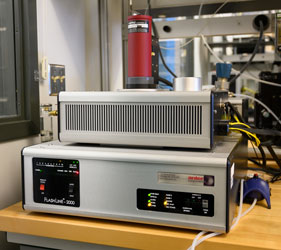 Flash Diffusivity measures how well energy can be transferred through a sample. The
process for measuring thermal diffusivity of a material is done by hitting one side
of the sample material with a pulse of intense light and monitoring the other side
of the sample for temperature change. The trend of time and temperature is measured
and the several rise times are determined from the trend. The measured half rise time
can be input into a model to determine the thermal diffusivity of a material. Specific
heat can be determined by running a sample with known specific heat capacity and then
running the unknown sample.
Flash Diffusivity measures how well energy can be transferred through a sample. The
process for measuring thermal diffusivity of a material is done by hitting one side
of the sample material with a pulse of intense light and monitoring the other side
of the sample for temperature change. The trend of time and temperature is measured
and the several rise times are determined from the trend. The measured half rise time
can be input into a model to determine the thermal diffusivity of a material. Specific
heat can be determined by running a sample with known specific heat capacity and then
running the unknown sample.
- Flashline 2000 from Anter Corp
- For determination of thermal diffusivity, thermal conductivity given specific heat
- Specimen types: solid (round or square), film, liquid, powder, fiber, molten metals
- Thermal Diffusivity range: 0.001 cm2/s to 10 cm2/s
- Thermal Conductivity range: 0.1 W/mK to more than 2000 W/mK
- Temperature up to 300° C
- High speed Xenon discharge pulse source
- Accommodates up to 4-sample system
Instrument Manager: Bill Butler